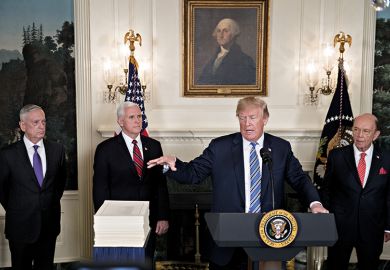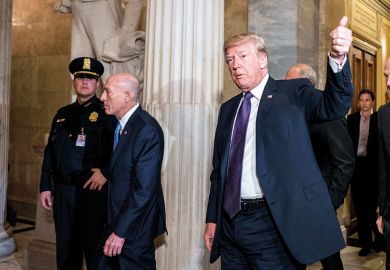Leaders of the US Congress have reached agreement on a higher education budget for the coming fiscal year, which includes substantial increases in grant money for low-income students and in university research spending.
The compromise among House and Senate leaders would raise the maximum award in the Pell Grant system – the chief federal support for needy students – by $100 (£77) from $6,095 to $6,195, beginning with the next academic year.
The agreement also provides more than $39 billion for the National Institutes of Health, the largest single provider of university research money, which would be a single-year increase of $2 billion or about 5.4 per cent.
The House-Senate leadership plan, for the federal fiscal year that begins on 1 October, is virtually certain to win approval in the two houses of Congress and be enacted by President Donald Trump.
The increases for key higher education programmes nevertheless stand as a rebuke to the president, who for two consecutive years has proposed deep cuts in college-related spending and has now had such ideas largely reversed by the Republican-led Congress.
Republicans have mostly backed Mr Trump on policy language in areas such as easing legal restrictions on for-profit colleges and weakening consumer protections for students. But when it comes to actual dollars affecting families, lawmakers on both sides tend to listen to their constituents, said Jon Fansmith, director of public affairs at the American Council on Education, the nation’s leading higher education lobby group.
Beyond the Pell Grant programme, the House-Senate budget agreement also provides funding levels in college-related spending for fiscal year 2019 at or above current-year amounts. That includes direct aid to institutions, typically those that primarily serve minority students, which was increased by about 1 per cent.
“Congress has shown absolutely zero interest in doing those cuts,” Mr Fansmith said of the Trump administration’s budget recommendations. “And, in fact, quite the opposite.”
Other surprising gains in the agreement, Mr Fansmith said, include a provision for a suspension of payments by student loan borrowers diagnosed with cancer. He said this is a more specific expansion of existing provisions for hardship forbearances.
One small downside to the Pell Grant increase, Mr Fansmith said, is a provision that trims the scheme’s $7.4 billion reserve surplus by about $1 billion, some of which will be used to cover the cost of the $100 increase. The reduction is “understandable in some ways”, although the surplus is a necessary guard against sudden upturns in demand for Pell Grants, he said.
With no agreement in place on other parts of the fiscal 2019 budget, the US government has been facing a potential shutdown from 1 October. House and Senate leaders, however, have also reached an agreement to continue existing funding levels through to 7 December for all unresolved portions of the federal budget, to allow more time for negotiations.
Register to continue
Why register?
- Registration is free and only takes a moment
- Once registered, you can read 3 articles a month
- Sign up for our newsletter
Subscribe
Or subscribe for unlimited access to:
- Unlimited access to news, views, insights & reviews
- Digital editions
- Digital access to THE’s university and college rankings analysis
Already registered or a current subscriber?








